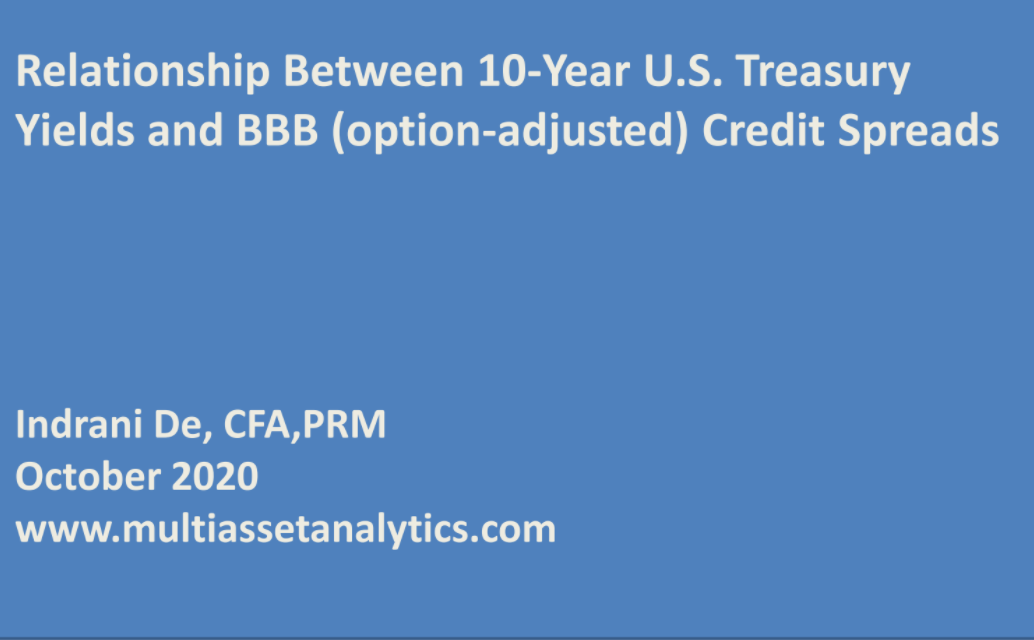Research

Asset Allocation and Top-Down Portfolio Construction
In this presentation made to the Financial Accounting Standards Board (FASB) in October 2021, as part of their ‘Think Like an Investor’ series, I draw upon my experience to highlight important issues in top-down multi-asset portfolio construction. I mention well-known empirical findings on the key value addition from asset allocation in portfolio construction, discuss the different types of asset allocation and how capital market assumptions are the foundational block. I also presented my ideas on the increasingly important topic of the financial implications of climate change by presenting a few highlights from my peer-reviewed research paper ‘Incorporating Climate Change in Asset Allocation and Portfolio Construction’, which has been accepted for publication in the forthcoming book titled ‘Climate Change: Managing the Financial Risk and Funding the Transition and Adaptation’, to be published by Risk.net in early 2022.

Climate Change, ESG Investing, ESG Data with implications for CRE and CMBS
I recently presented at the DBRS Morningstar webinar (panel discussion) on “Climate Change, ESG Investing, ESG Data with implications for CRE and CMBS”. It was a well-rounded discussion on ESG factors impacting CRE and implications for CMBS, with perspectives on trends in quantifying climate change data, how and why it matters to investors in fixed income and real assets, the growth of investor interest in sustainable investing, DBRS Morningstar’s ESG initiatives and criteria, and the CMBS credit rating process incorporating these critical issues.

ESG Investing in Public Equity Markets
Delighted to have presented on ESG investing to 2nd year MBA students at Columbia Business School on March 17/2021, as part of their course “ESG Investing in Public Equity Markets”. The presentation was based on my Journal of Investing (2015) paper on using ESG factors in active management for portfolio construction. It explores the predictive power of ESG on returns, volatility and risk adjusted returns of individual securities, and on tail risk, portfolio risk and risk-adjusted return using Portfolio Opportunity Distributions (POD). The main results were that higher return stocks almost always had higher average ESG rating, and stocks with the maximum return that active managers try to identify were always from the non-lower-tail (ESG) group. There was a strong negative correlation between ESG ratings and stock volatility, and this relationship was stronger when market volatility was higher and therefore higher need for diversification benefits. The return profile of random portfolios created from (a) the full sample and (b) a smaller universe created by deleting lowest-rated ESG companies as a tail risk, indicated that deleting worst ESG rated stocks did not necessarily impose opportunity costs and, in fact, tended to be value additive for investors in terms of portfolios with higher average and maximum return. This implies that asset managers can enhance their stock-picking and portfolio construction ability by using ESG information and even more so by excluding the worst ESG stocks.

ESG Investing Part 3: ESG Across Asset Classes and in Asset Allocation
The changing nature of corporations with intangibles driving a greater proportion of enterprise value is a key reason for ESG being an increasingly important data point. ESG has varied impact on return and risk across different asset classes. The use of ESG data started in equities and given the asymmetric return emphasis between equities and bonds (upside capture for equities and preventing downside risk in bonds), is rapidly becoming important in different parts of fixed income given its predictive value over and above the information in credit ratings. This research analyzes recent empirical studies to document the predictive ability of ESG across asset classes (equity, different parts of fixed income, credit, and real assets), how and why it can be used in security selection and asset allocation to design optimal risk-adjusted portfolios.

Inflation Outlook: So Many and Contradictory Forces on Inflation
An outlook on growth and inflation is the starting point for all capital market assumptions, strategic asset allocation, tactical investment strategies and portfolio construction. There are many factors impacting inflation - cyclical or structural issues, the timing of their impact and whether it is inflationary or deflationary, and if inflationary then ‘good’ or ‘bad’ inflation. This research analyzes some key issues to identify the net impact and the most probable inflation outlook along with implications for portfolio construction.

ESG Investing Part 2: Firms with Controversies - One Time Event or a Trend?
An issue that is often discussed in ESG investing is whether a firm mired in a controversy is having a one-off event, or is it part of a trend pointing to underlying ESG issues? This question has important implications for the performance of its equity and debt securities. This is a meta-analysis piece based on published research papers.

ESG Investing Part 1: Multiple Ratings Cause Confusion
There is unprecedented interest in ESG (Environment, Social, Governance) investing, also known as sustainable or responsible investing. However, the top concern among investors looking to integrate ESG into their investment process is the issue of multiple ESG rating providers, and the fact that the same corporate may get vastly different ESG ratings from different ESG raters. Why does that happen? What to do about it?

Inter-linkages among different asset classes: Equities and Credit
Globalization and increased capital flows have led to equity markets across different parts of the world to be highly correlated, and this is a well-accepted data point. Less well understood are the high inter-linkages among different asset classes. This research piece looks at two large asset classes – equities and credit.

Uncertainty: Impact on Economy and Financial Markets
“Uncertainty” is not just a nebulous concept. It is identifiable as Economic Policy Uncertainty, Political Uncertainty, or a combined measure of Uncertainty. It can be measured for the U.S and globally, and its impact on the economy and financial markets has been analyzed and quantified

Relationship between 10-Year U.S. Treasury Yields and BBB (option-adjusted) Credit Spreads
A key aspect of multi-asset analysis is knowing the relationship between important financial variables. So, what is the relationship between U.S. 10-year Treasury Yields and BBB (option-adjusted) credit spreads? This is an important relationship for bond yields.

How much does the Fed really ‘control’ the 10-year Treasury yield?
The biggest driver of the 10-year treasury yield is the term premium, NOT the Fed funds rate. The term premium is a variable outside the Fed’s control and impacted primarily by global factors.

Quit Ratio: A Leading Indicator in Labor Market
It is important to interpret the information content of economic indicators based on whether they are leading, lagging or coincident indicators.

Strategic Equity Allocation Insights
The ‘Buffett Indicator’ defined as [Total Stock Market Capitalization/Gross Domestic Product] in the U.S. is at record high; 2020 YTD average at levels just prior to bursting of the dot-com bubble.

Signs Of Global Recovery
Global manufacturing back in expansion, more than half the world in expansion now, along with high frequency indicators from the NY Fed indicate tailwinds to an U.S recovery.

ESG and Resilience in Corporate Performance
ESG investing, stakeholder capitalism, economic intuition (that which makes a company operationally succeed, in turn makes it a potential for equity investment or credit lending) – I have always written that they are different names for the same thing.

From Income Inequality to 10-Year U.S Treasury Yield
The issue of inequality in the U.S. is increasingly being discussed, given the recent social unrest. However, inequality is an issue with tremendous impact on the macroeconomy and financial markets.